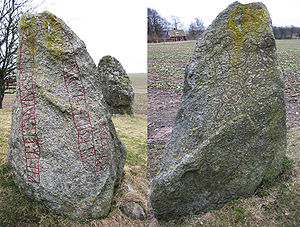The Västra Strö 2 Runestone, listed as DR 335 in the Rundata catalog, is a Viking Age memorial runestone located at the Västra Strö Monument, which is at a church that is about four kilometers northwest of Eslöv, Skåne County, Sweden.

Description
editThe Västra Strö Monument consists of five standing stones and two runestones, DR 355 and the Viking runestone DR 334. The two stones have a Danish Rundata catalog number because Scania was part of the historical Denmark during the Viking Age. The monument was surveyed in the 17th century by the Danish antiquarian Ole Worm who documented the inscriptions and reported that it was in good condition.[1] This was not the case during a second survey in 1876 when all stones except one were found to have fallen. The Lund Kulturen restored the monument in 1932.
When the stone was raised in 1932, a mask of a man's face was discovered on the other side. This is a common motif and is found on several other runestones including DR 62 in Sjelle, DR 66 in Århus, DR 81 in Skern, DR 258 in Bösarp, the now-lost DR 286 in Hunnestad, DR 314 in Lund, Vg 106 in Lassegården, Sö 86 in Åby ägor, Sö 112 in Kolunda, Sö 167 in Landshammar, Sö 367 in Släbro, Nä 34 in Nasta, U 508 in Gillberga, U 670 in Rölunda, U 678 in Skokloster, U 824 in Holms, U 1034 in Tensta, and U 1150 in Björklinge, and on the Sjellebro Stone.[2]
The Västra Strö 2 Runestone consists of runic text in an arch that is classified as being carved in runestone style RAK, which is considered to be the oldest classification. This is the classification for inscriptions that have straight text band ends without any attached serpent or beast heads. Each word in the runic text is separated by a two dot word divider punctuation mark. Runic inscriptions are often dated based upon comparative linguistic and stylistic analysis, and the inscription on DR 335 has been dated to approximately the period of 960 to 1050 C.E.[3]
The runic text states that Faðir raised the stone as a memorial to Bjôrn, with whom he owned a ship, and Faðir likely created the Västra Strö Monument.[4] Faðir also sponsored DR 344, which is a memorial to his brother Ôzurr, who died i wikingu or on a Viking raid or expedition. It is possible that Faðir and Bjôrn also went on this joint expedition.[4] The brother Ôzurr is not mentioned as having a part owner the ship.[4] Other runestones that state that the deceased was a ship owner include DR 68 in Århus and U 778 in Svinnegarn.[4]
The stone is known locally as the Västra Ströstenen 2.
Inscription
editfaþiʀ
Faðir
Faþiʀ
:
lit
lét
let
:
hukua
hǫggva
hoggwa
:
stin
stein
sten
:
þan(s)i
þenna
þænsi
:
uftiʀ
eptir
æftiʀ
:
biurn
Bjǫrn,
Biorn,
:
is
er
æs
:
skib
skip
skip
:
ati
átti
atti
:
miþ
með
mæþ
:
anum
honum.
hanum.
:
Faðir had this stone cut in memory of Bjǫrn, who owned a ship with him. [5]
References
edit- ^ Ole, Worm (1643). Danicorum Monumentorum. Copenhagen. pp. 146–148. Archived from the original on 2011-07-19. Retrieved 2010-09-13.
- ^ Bertelsen, Lise Gjedssø (2006). "On Öphir's Pictures". In Stoklund, Marie; Nielsen, Michael Lerche; et al. (eds.). Runes and Their Secrets: Studies in Runology, Volume 2000. Copenhagen: Museum Tusculanum Press. pp. 46–47. ISBN 87-635-0428-6.
- ^ Sawyer, Birgit (2000). The Viking-Age Rune-Stones: Custom and Commemoration in Early Medieval Scandinavia. Oxford University Press. pp. 28–35, 204. ISBN 0-19-820643-7.
- ^ a b c d Jesch, Judith (2001). Ships and Men in the Late Viking Age: The Vocabulary of Runic Inscriptions and Skaldic Verse. Woodbridge: Boydell Press. pp. 56, 180–181. ISBN 0-85115-826-9.
- ^ "Runic inscription DR 335". Scandinavian Runic-text Database (2020 ed.). Uppsala University: Department of Scandinavian Languages. Retrieved Feb 25, 2024.
Other sources
edit- This article contains some information from the Swedish Wikipedia article Västra Strömonumentet.
External links
edit- Maskesten - Billedsten fra Vikingtiden - Arild Hauge webpage on mask stones
Gallery
edit-
Drawing of the Västra Strö Monument published by Old Worm in 1643
-
The inscription on DR 334 states "Faðir had these runes cut in memory of Ôzurr, his brother, who died in the north on a viking raid."